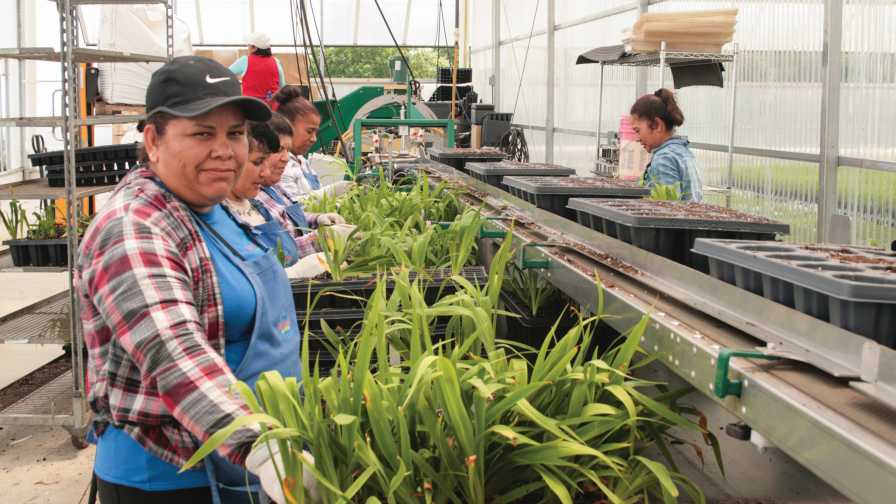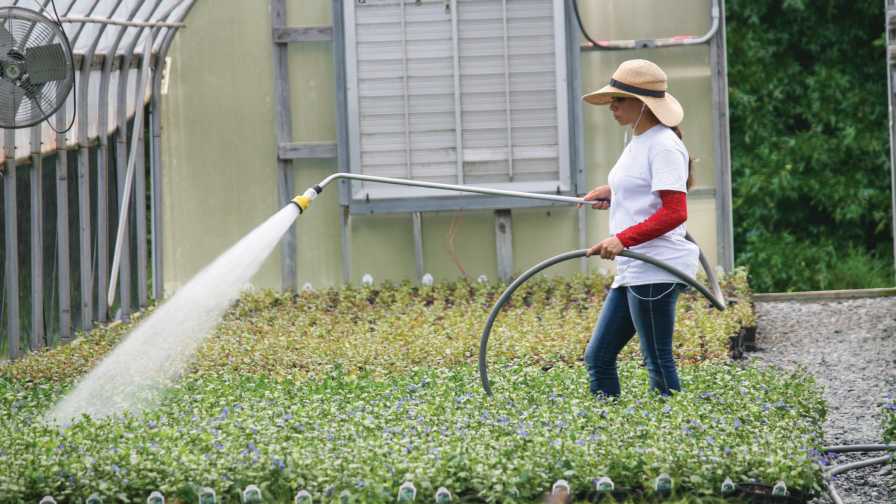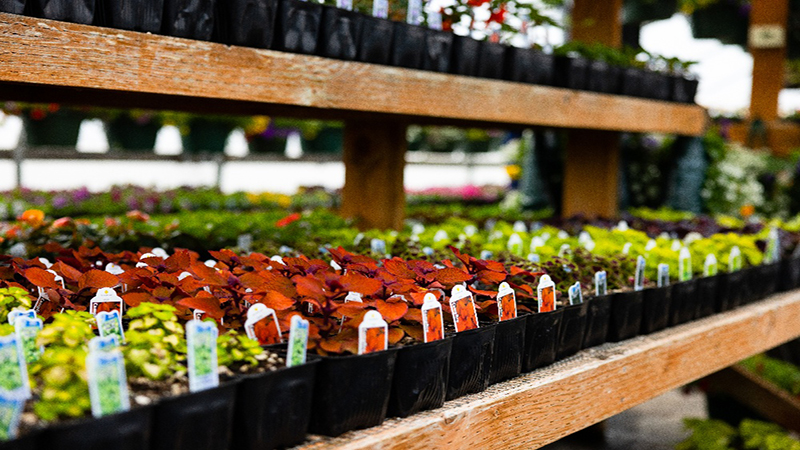This Month’s Cover Story: Help Wanted for Greenhouse Growers, but Only If It Fits

With a limited labor pool to choose from, finding employees who are self-motivated, work with minimal supervision, and know how to work has become increasingly difficult for employers.
The green industry doesn’t have a labor problem; it has a people problem. In a job market with record-low unemployment rates, workers are difficult to find. Yet, this is only one piece of the puzzle. Employers’ long-term success may hinge more on finding the right type of employee ─ one equipped with the skills and work ethic to be an asset to the company rather than a drain on its resources.
Warm-Body Hiring vs. Hiring Quality Talent
While ornamentals, vegetables, and cannabis/hemp growers experience labor struggles unique to their individual markets, the increasing imbalance between supply and demand for available talent is a challenge they all share. Prospective workers also can afford to be more selective about their place of employment, which makes attracting and retaining them more difficult, especially in industries where the seasonality and the nature of the work are not looked on favorably.
“I think rather than certain commodities competing against one another, the problem is that, in these days of virtually full employment, U.S. workers have choices and given the choice they will seek year-round employment in sectors like construction, which can offer higher wages and benefits packages most seasonal agricultural employers cannot,” says Kerry Scott, Program Manager for MAS Labor.
One unfortunate result of the labor shortage is that some growers find themselves forced to settle for procuring any warm body willing to fill an empty spot, all the while preferring to have a vastly different worker in the role who is self-motivated, works with minimal supervision, and knows how to work. This dilemma is one cannabis growers know all too well. Depending on the region, there seems to be no shortage of people wanting to work in the cannabis industry, but workers attracted by the lucrative opportunities don’t always have the skills or drive to make meaningful contributions.
“What we are seeing is the 80/20 rule,” says C.J. Swickey, a cannabis/hemp grower based in Oklahoma.
“Twenty percent are workers who get tasks done and are looking to do the next task. The other 80%, you need to almost hold their hands and show them each task that needs to be done each day and how to do it. I am happy if I find one worker out of 10 that can be given a set of tasks after training and that needs little supervision.”
The cannabis industry not only needs good workers, it needs professionals dedicated to improving the industry’s image. As the industry continues to shed its “Reefer Madness” past, professional growers play more of a key role in helping to elevate the industry to new levels where it is taken seriously. Basement growers, in some cases, and others looking to make their fortune by whatever means necessary have become a liability to the industry.
“Leaders in the cannabis industry want to increase the number of professionals with specific horticulture and/or consumer product knowledge and decrease the number of basement growers or people simply jumping into the industry because it is either the popular niche or they mistakenly think it is a quick way to make money,” says Todd Downing, Managing Partner and Co-Founder at Best Human Capital and Advisory Group.
Money a Limiting Factor When Attracting Labor
Economics plague ornamental and vegetable growers as well, although in much different ways. Specialty greenhouse vegetable growers must compete with field growers on vegetable pricing, while ornamental growers struggle with receiving low profit margins for their products. This has resulted in a push in both industries for cost-effective growing systems and automation that lessens the demand on labor, as well the search for professionals with horticultural and technology/engineering backgrounds. Unfortunately, it also limits employers’ ability to offer appealing compensation packages, making it difficult at times to attract younger candidates entering the workforce and retain experienced labor.
Until we see either a level [profit] margin field for each industry niche [vegetables, ornamentals, cannabis/hemp] or we attract more professionals to a career in the green industry, there will be competition between all three to get the talent that is there, Downing says, and the sector with the weakest margins will continue to experience challenges.
While the ornamental industry currently falls in the weak margins category, it may not be at a disadvantage forever. As more ornamental growers shift their production over to cannabis, hemp, or specialty vegetables, this turn of events may work in its favor to drive up prices and, by extension the compensation amounts and benefits companies can offer, thus in theory helping to attract more workers to the industry.

Offering employees other benefits that go beyond basic pay, such as flexible work schedules and bonuses, has helped some greenhouse companies attract workers in a competitive labor market.
But Not Always
Until then, necessity is the mother of invention, and thankfully it drives companies in all crop markets to creatively attack the labor problem on several fronts that go above and beyond basic pay. Swickey says he is exploring offering benefits to his employees such as onsite childcare and flexible work schedules. For other growers, gift cards and bonuses work well as incentives to meet production goals. Some have found offering to pay workers a bonus motivates them to finish up work in 40 hours. Growers also say holding employee appreciation events and improving the workplace environment helps keep employees happy.
Cherrylake/IMG Enterprises in Groveland, FL, a growing operation with more than 1,800 acres of containerized trees, shrubs, and palms, and one of Florida’s largest fresh citrus distributors with more than 8,700 acres of grapefruit, tangerine, and orange groves, has created a list of skills/tasks for each job at the nursery by department. It uses this list to train workers and evaluate their proficiency, and it has based a four-tiered pay matrix off these skills that ranges from entry level to crew leader. As employees gain more skills and increase their proficiency, they move up the pay matrix.
“What we have found over the years is that we keep needing to increase the floor and ceiling of the matrix to ensure we are within market range,” says Todd Gentry, Director of Production at Cherrylake/IMG Enterprises. “We are not competing with other farms for labor as much as we are competing with construction companies.”
In addition to the traditional health care and dental offerings, Cherrylake offers fringe benefits such as steady, year-round work at one location, a guaranteed 40-hour minimum work week, and a great company culture. New workers receive a $200 bonus after 30 days of employment, and existing employees collect a $100 bonus when someone they refer stays with the company at least 30 days. Salaried staff can participate in a cost-share program, while a tenureship program for hourly staff pays a certain amount for every year they are with the company, starting at three years.
Cherrylake/IMG Enterprises recently hired its first North American Free Trade Agreement (NAFTA) employee with a four-year degree through the TN1 visa program. It turned to the program after a fruitless two-year search to fill an open position for a skilled professional. Gentry says the company received lots of applications through the TN1 visa process and was able to fill the position quickly as a result.
Patterned after the H-1B visa, the nonimmigrant NAFTA Professional (TN) visa allows U.S. employers to hire citizens of Canada and Mexico as NAFTA professionals for prearranged business activities. The visa is good for three years with the option to renew it indefinitely, and the documentary requirements are less cumbersome than for H-1B visas. Prospective employees must have a job offer in the U.S. in an eligible profession. They must also meet the educational qualifications for the job.
TreeSource Citrus Nursery, a full-service commercial growing operation based in California with 30,000 square feet of greenhouses and nearly 3 acres of insect-excluding structures for seedling, tree, and liner production, discovered three years ago that temp agencies viewed nurseries similar to businesses like manufacturing factories or packing houses. It took about two years of the company’s managers working through excessive turnover with the temp agency and eventually supplying an introductory video showing the type of work required before the agency started to improve at recruiting workers, but the extra efforts and patience have paid off.
“Our turnover problems have disappeared,” says General Manager Roger Smith. “We also discovered that the agency workers were better educated and that there are good workers that don’t want 12-month employment. They use the agency for the months they want to work. As we have seasonal work, these workers are well suited to our operation.”
What’s Ahead
Green industry companies also continue to turn to the H-2A program for relief, despite the obstacles and expense. With the work involved in obtaining these workers, companies often choose to let a third party navigate through the process in their behalf.
“On the face of it, H-2A seems (and probably is) expensive and can be something of a bureaucratic nightmare, but with the help of a good agent, H-2A works,” Scott says. “Almost without exception, growers who try H-2A stay with H-2A and often say they wish they had taken this route years ago.”
Companies continue to hope that labor reforms are on the horizon. At the end of October, a group of bipartisan House lawmakers introduced a comprehensive agricultural labor reform bill with a three-pronged approach to tackle existing workforce issues, H-2A reforms, and the phasing in of e-verify, consistent with the other reforms. In a recent video update, Senior Vice President Craig Regelbrugge said that while the bill isn’t perfect, AmericanHort plans to support the legislation in the House and will continue to seek targeted improvements as the legislative process moves forward to the Senate.










